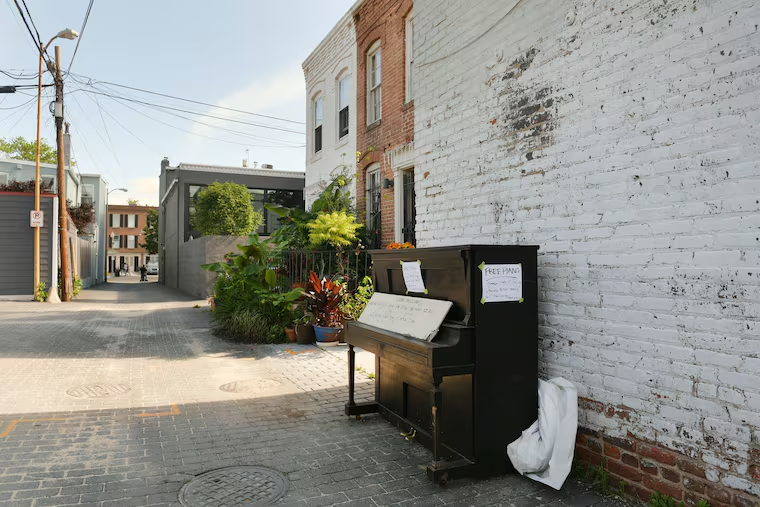Considering parting with your piano? It won’t be easy.
The piano, once the pride of many American living rooms, seems out of tune with a growing number of households. If you need to get it out of your house, often you can't sell it or even give it away.

Taking a shortcut through an alley on Capitol Hill in Washington, Amy Moore was both amused and crestfallen to come across an old upright piano pushed up against a brick wall with the sign “Free Piano.”
“I know it’s super-duper expensive to move a piano,” says Moore, executive director of the Capitol Hill Arts Workshop. “What immediately went through my mind were visual images of how this piano might have been used. Maybe a family once sat around it or a kid took lessons on it? Why was it discarded? Pianos bring people together; they are part of celebrations. It kind of made me sad to see it out there in the alley.”
The piano, once the pride of many American living rooms, seems out of tune with a growing number of households. People who own old uprights, especially the oak and walnut ones, often have the same problem as those with homes full of traditional brown furniture: When you need to get it out of your house, you can't sell it or even give it away.
Although this will make music lovers cringe, the reality is that some pianos have become disposable. There are lots of them around, some not in great shape. Although memories of an instrument may spark joy, sometimes circumstances dictate that a piano be let go. Downsizing boomers often don't have room for them; millennials can't (or won't) squeeze them into urban quarters; teens often learn to play on electric keyboards.
"They often just won't fit," says Libby Kinkead, one of the owners of Potomac Concierge, which offers downsizing and moving services. Sometimes "people have to choose between their couch and their piano."
Their sheer weight — 500 to 1,200 pounds — makes them difficult and costly to move: Fees can start at $200 for uprights and $300 for baby grands, plus extra for stairs and distance. Then there are tuning costs. But anyone looking for a piano is in luck: Plenty are available free if you pay for the move. The downside: Many more old pianos end up in landfills, some after being chopped up so they’ll fit in a truck.
It can be painful to see a precious family instrument relegated to a dump when all other efforts to find it a new home have failed. Mark Rubin, who owns 12 franchises of 1-800-GOT-JUNK, says his employees have seen customers in tears as their pianos are hauled away. “Pianos are something very hard to get rid of. They hold a lot of memories.”
A century ago, pianos were a must in a fashionable home, but New York design historian Emily Eerdmans says they are no longer status symbols.
“Pianos started in the place of honor in the living room, and gradually they moved to the family room,” she says. “Today people don’t gather around a piano, they gather around a screen.”
Fewer people are buying pianos. In 2018, 30,516 new pianos were shipped to retailers in the United States, down 3.2 percent from 2017, according to Industry Census of Music Trades, a magazine that covers music products. The postwar peak for the piano industry was 1978, when 282,000 units were shipped, according to Brian Majeski, editor of Music Trades.
“A piano was part musical instrument and part aspirational item. You can trace this back to Jane Austen novels,” Majeski says. “Now it’s just a musical instrument. The people who buy it are the people who play, and this is a smaller set of the population.”
There are various ways to de-accession a piano. None is easy. Many an owner has envisioned a loving second home for their prized instrument — or at least a hefty sales price. Most will find neither.
Ebonized pianos by Steinway, Yamaha and Kawai are models that sell best at Weschler’s Auctioneers and Appraisers in suburban Rockville, Md., says vice president Mark Weschler. He often advises clients clearing out estates that old dark wood pianos are not worth auctioning and are best donated. If in bad condition, a removal service is suggested.
Many churches, schools and senior centers already have as many as they need. At Levine Music, a center for music instruction and education with 300 Steinway pianos on five local campuses, a piano might be accepted for donation if it’s in good condition and passes an assessment by a Levine piano technician. Steinways will be put to use in teaching studios; other uprights or spinets might go to the school’s piano loaner program, according to Stan Spracker, Levine’s president.
Some pianos don’t come and go so easily. Margo Prator reluctantly scheduled a pickup last month with 1-800-GOT-JUNK to remove the cherry upright her parents bought in the 1950s. But she canceled. “I just wasn’t ready,” she says. She had offered it to a school, posted it on an internet mailing list, and tried to get her brother to put it in his beach house.
"It makes me sad they will take it to the dump," Prator says, "not only because it's a piece of history, but it's a musical instrument."